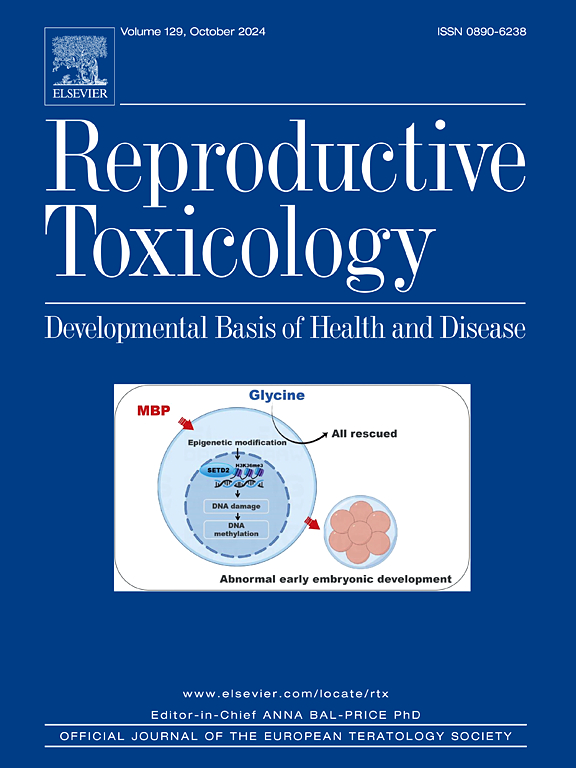氟暴露对生殖健康的影响:对分子机制和健康影响的见解
IF 2.8
4区 医学
Q2 REPRODUCTIVE BIOLOGY
引用次数: 0
摘要
虽然氟化物在预防龋齿方面的好处是公认的,但人们对高摄入量的潜在毒性的担忧正在上升。本综述在分子水平上调查慢性氟暴露与生殖健康结果之间的联系,重点关注氟中毒和非氟中毒地区的人口增长和儿童性别比例。有必要探讨氟化物对男性和女性生殖系统的有害影响。在男性中,利用分子标记、表观遗传学、转录组学和蛋白质组学数据,研究激素变化、精子发生、获能和精子活力的改变。对于女性,使用类似的方法,激素失衡,卵母细胞形成中断,致畸(先天性残疾),以及由于母亲氟中毒而损害婴儿发育。此外,我们探索了解决受影响途径的药物,维生素和自然疗法的潜在益处,以及改变生活方式以尽量减少不良反应。各种分子通路的影响,如细胞凋亡、自噬、DNA损伤、激素失衡、炎症反应、线粒体动力学和细胞信号通路,与慢性和特定剂量氟化物引起的生殖毒性有关。分析现有研究和探索潜在的治疗途径有助于制定战略,保障高氟化物暴露人群的生殖健康。本文章由计算机程序翻译,如有差异,请以英文原文为准。
Impact of fluoride exposure on reproductive health: Insights into molecular mechanisms and health implications
While the benefits of fluoride in preventing dental caries are well-established, concerns about its potential toxicity at high intake levels are rising. This review investigates the link between chronic fluoride exposure and reproductive health outcomes at the molecular level, focusing on population growth and child sex ratios in the fluorosis-affected and non-fluorosis regions. The exploration of the detrimental effects of fluoride on both male and female reproductive systems is necessary. In males, hormonal variations, alterations in spermatogenesis, capacitation, and sperm motility using molecular markers, epigenetic, transcriptomic, and proteomic data. For females, hormonal imbalances, disruptions in oocyte formation, teratogenicity (congenital disabilities), and compromised infant development due to maternal fluorosis using similar approaches. Furthermore, we explored drugs that address affected pathways, the potential benefits of vitamins and natural remedies, and lifestyle modifications to minimise adverse effects. The impact of various molecular pathways like apoptosis, autophagy, DNA damage, hormonal imbalance, inflammatory response, mitochondrial dynamics, and cell signalling pathways has been linked to reproductive toxicity induced by chronic and specific doses of fluoride. Analysing existing research and exploring potential therapeutic avenues contributes to the development of strategies to safeguard reproductive well-being in populations exposed to high fluoride levels.
求助全文
通过发布文献求助,成功后即可免费获取论文全文。
去求助
来源期刊

Reproductive toxicology
生物-毒理学
CiteScore
6.50
自引率
3.00%
发文量
131
审稿时长
45 days
期刊介绍:
Drawing from a large number of disciplines, Reproductive Toxicology publishes timely, original research on the influence of chemical and physical agents on reproduction. Written by and for obstetricians, pediatricians, embryologists, teratologists, geneticists, toxicologists, andrologists, and others interested in detecting potential reproductive hazards, the journal is a forum for communication among researchers and practitioners. Articles focus on the application of in vitro, animal and clinical research to the practice of clinical medicine.
All aspects of reproduction are within the scope of Reproductive Toxicology, including the formation and maturation of male and female gametes, sexual function, the events surrounding the fusion of gametes and the development of the fertilized ovum, nourishment and transport of the conceptus within the genital tract, implantation, embryogenesis, intrauterine growth, placentation and placental function, parturition, lactation and neonatal survival. Adverse reproductive effects in males will be considered as significant as adverse effects occurring in females. To provide a balanced presentation of approaches, equal emphasis will be given to clinical and animal or in vitro work. Typical end points that will be studied by contributors include infertility, sexual dysfunction, spontaneous abortion, malformations, abnormal histogenesis, stillbirth, intrauterine growth retardation, prematurity, behavioral abnormalities, and perinatal mortality.
 求助内容:
求助内容: 应助结果提醒方式:
应助结果提醒方式:


